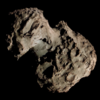Comet Bennett, formally designated as C/1974 V2, is a non-periodic comet that was seen in 1974. During its most recent perihelion, the comet was observed to split apart and disintegrate.[5]
Discovery and observations
On the morning of 13 November 1974, John Caister Bennett discovered his second comet as a diffuse 9th-magnitude object in the constellation Hydra using a 125 mm (4.9 in) refractor from Pretoria, South Africa.[a] He had spent a total of 482 hours searching for a new comet since his first discovery in 1969. At the time, the comet had no discernible coma nor tail, however Bennett was of the opinion it experienced an outburst lasting about five days just before discovery[6]
References
Notes
Citations
- ^ B. G. Marsden (14 November 1974). "Comet Bennett (1974h)". Central Bureau for Astronomical Telegrams. 2719.
- ^ "Comet Names and Designations". International Comet Quarterly. Retrieved 3 December 2024.
- ^ "C/1974 V2 (Bennett) – JPL Small-Body Database Lookup". ssd.jpl.nasa.gov. Jet Propulsion Laboratory. Retrieved 12 December 2024.
- ^ a b G. W. Kronk (1999). Cometography: A Catalog of Comets. Vol. 5: 1960–1982. Cambridge University Press. pp. 434–436. ISBN 978-0-521-87226-3.
- ^ "Split comets". International Comet Quarterly. Retrieved 12 December 2024.
- ^ J. C. Bennett (1974). "How I found comet 1974h". The Astronomer. 11: 157–158. Bibcode:1974Astr...11..157B.
External links
- C/1974 V2 at the JPL Small-Body Database











You must be logged in to post a comment.